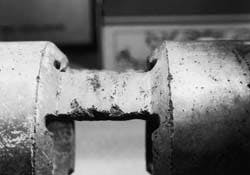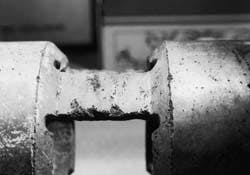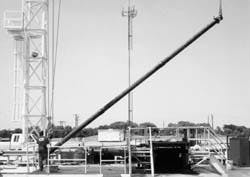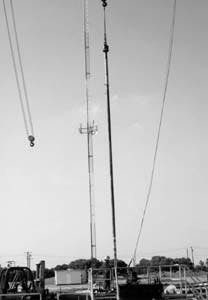Full-scale tests help improve reliability of DST tools
Paul Ringgenberg
Halliburton Energy Services
DallasJohn C. Self
Statoil
Stavanger, Norway
A joint-industry project set up procedures and full scale tests to determine the reliability and integrity of drill stem test (DST) tools for use in difficult high pressure, high temperature wells.
These DST tool tests helped determine changes needed to address reliability in high pressure, high temperature (HPHT) conditions and has demonstrated that DST tools could maintain integrity in this type of environment.
The reliability of a drill stem test can be increased by planning and cooperating with other operators and service companies. Operators can then share information about successful tool combinations and operating procedures.
The quality and reliability of both the drilling mud and DST tools are important to ensure meaningful well test information. The tool service company and the mud company can perform a more satisfactory service if sufficient time has been allowed for them to plan and prepare for the HPHT test.
North Sea operators often experience reliability problems with drill stem testing (DST) tools in high pressure, high temperature environments. HPHT environments are normally defined as having hydrostatic pressures of at least 10,000 psi and bottom hole temperatures of at least 300° F. Factors affecting reliability may include deteriorating mud conditions caused by increased depth and temperature, high pressures which hinder tool operation, and reduced sealing capability resulting from the high temperatures.
Eleven major operators and service/testing companies in the Norway/U.K. area undertook a joint industry study to address these problems and to determine methods to increase the reliability of DST operations in HPHT well testing. Emphasis was placed on the selection of the downhole equipment used for the HPHT drill stem tests and design of the full scale testing of the North-Sea-area field tools in use. Additionally, an investigation was to be made to establish methods that could be used to verify and increase equipment reliability. The project also included design parameters for contingency conditions that were not normally present during equipment operations but could exist in emergency situations.
Eleven tools, including tester valves, multiple-cycle circulating valves, bypass valves, and safety/circulating valves, from different service company/suppliers were rigorously tested. The method of testing helped determine changes needed to address reliability in HPHT conditions and has demonstrated that DST tools could maintain integrity in this type of environment.
For more than 60 years, drill stem testing has been used to determine reservoir parameters of potential producing zones. The early DST applications were traditionally limited to open hole at low-to-moderate temperatures and pressures. These conditions would include temperatures of between 150 and 300° F. and pressures ranging from 1,000 to 10,000 psi. With the expansion of offshore DSTs to cased-hole applications with temperature ranges up to 410° F. and hydrostatic pressures up to 15,000 psi, traditional equipment experienced operational problems.
These problems included the following in descending order of relative frequency:
- Mud deterioration resulted from mud remaining static at a high temperature for several days. In water-based systems, settling of solids caused the string to become stuck in the hole and created plugs of solids that hindered pressure transmission to the tools. In oil-based systems, increases in viscosity and gel strength reduced the capability to transmit operating pressures to downhole tools.
- Some tool designs were not fully suited for the conditions. This included insufficient pressure capabilities, especially in the area of air chambers. Shear-pin-operated tools were susceptible to pressure and shock from the perforating guns, and string designs were too complicated for the conditions. For example, several annular-pressure-operated tools were run with operating pressures that were too close together because of an insufficiently low pressure test of the casing or liner lap.
These problems indicated that in addition to solutions for the mud problems, reconfiguration of tools would also be necessary if DST applications were to be provided in the expanded testing environments.
Mud system improvements
Improvements in DST mud systems during the past decade have greatly improved the reliability of testing in HPHT wells. It was recognized that the HPHT testing environment de manded a mud system designed to handle long-term static conditions of testing and also have good pressure transmissibility after 1 week. Thus, several strategies were used to improve mud reliability, including the following:
- Replacing the old drilling mud with new mud immediately before the commencement of testing, or if the conditions were not extreme, fully reconditioning the present mud
- Using weighted, clear completion fluids such as calcium chloride and zinc bromide during testing
- Changing the system to a less-than-kill-weight fluid, such as seawater.
Although this greatly improves the reliability of the mud system, it also places special demands on the tools and workstring, as they must be able to handle the higher pressures inside the workstring. (Drill stem testing is commonly performed with higher pressure in the well annulus outside the tools so that the hydrostatic pressure of the annular mud column is sufficient to kill the well in case of an emergency.)
Tool system improvements
Although mud reliability increased, tool reliability was still a topic of concern. The need to address the equipment difficulties prompted the development of a consortium of 11 major oil companies with the common purpose of determining methods for increasing reliability of HPHT well testing operations.
The project parameters included full scale testing of assemblies as they would be combined in a testing system. Aside from the significant value that could be obtained for DST tools from the development of full scale testing methods, it was also felt that these methods could benefit non-DST equipment.
Drill stem testing
Drill stem testing is defined as a "temporary well completion effected for the purpose of sampling the formation fluid and establishing the probability of commercial production."1
As such, a DST is normally conducted to measure formation parameters and characteristics under dynamic conditions. These parameters include productivity, permeability, pressure, well bore damage, depletion, supercharge, permeability anomalies, and multiple zones. The primary method used to determine such parameters involves analyzing the pressure response to the flowing and closing-in of a well.
The DST provides the first opportunity for the formation to flow. There is usually some uncertainty as to whether the formation may or may not actually flow. However, the uncertainty of conditions during the DST has normally not been a problem because traditional well conditions, including additional pressure testing and tool operating pressures, are easily within the capabilities of the equipment. When traditional equipment is used in HPHT conditions, however, uncertainty is compounded by the fact that the conditions may cause the equipment to operate at its maximum limits or possibly in conditions that exceed its limits.
Although it is theoretically possible to perform an HPHT drill stem test in an open hole well bore, it is rarely attempted for the following well control reasons:
- A cased-hole DST is performed in a much safer environment because all zones are isolated by the cemented casing.
- The sealing of the packer seat is much more reliable inside the casing than in a section of open hole.
- In an open hole test, the packer has the potential of moving downhole, and the pipe could become differentially stuck against a lower pressure zone, requiring subsequent fishing of the string.
- In a cased hole test, the blowout preventer (BOP) rams can be shut during the entire test, greatly increasing the safety of the testing operations.2
HPHT project
The HPHT project defines HPHT wells as having anticipated closed in wellhead pressure of at least 10,000 psi or an anticipated bottom hole temperature of at least 300° F.3 During the initial determination of project parameters, four separate project sections were outlined: prediction, drilling, testing, and postanalysis. Although these topics are interrelated, this article primarily covers testing.
The project impetus came from Statoil, which had experienced a variety of problems during drilling and testing of an HPHT well. Because these problems greatly increased the operational time and cost of the well, the HPHT project was initiated to determine methods that might reduce the costs involved with operational procedures on future HPHT wells. Statoil believed a joint effort would provide increased cooperation, information sharing, and communication among major oil companies involved in planning, drilling, testing, and analyzing HPHT wells.
The companies participating in the testing portion of the HPHT program included Amoco Norway Oil Co., BP Exploration, Conoco Inc., Elf Petroleum Norge AS, Norsk Hydro AS, Mobil Oil Co., Phillips Petroleum Co. Norway, Saga Petroleum AS, A/S Norske Shell, Statoil, and Total. Statoil acted as project coordinator for the testing portion of the HPHT project and assumed the responsibility for performing all tool string designs, tool selections, testing procedures, design verifications, and witnessing the full scale testing.
Periodic updates to all team members assured that testing would satisfy as many members as possible. Two service company/suppliers also participated in the full scale testing of the annular-pressure-operated cased hole DST tools selected for the project.
Objective
The objective of a DST in high pressure, high temperature environments is to obtain as much information on the formation parameters as possible while minimizing risk and cost. The extremes in environment, however, can affect the testing by limiting either the duration of the testing or the selection of suitable equipment.
The conditions can also change during the duration of the test; for example, tools that operate perfectly during the first few days of the testing can become inoperable after a short period because of deteriorating mud conditions. Therefore, successful testing in HPHT conditions requires significant planning.4
HPHT tests have all the uncertainties of a normal DST, such as questionable mud conditions, drilling or perforating debris, unknown formation flow pressures, and unanticipated well production such as H2S. In addition, the probability of problems occurring are greater and the consequences more dangerous because of the risk and expense of controlling a high pressure formation. Because of the intricacies of these problems, HPHT tests are commonly designed to be as simple as possible, minimizing the total number of tools and operations required.3
HPHT testing places severe demands on the mud system. A mud that is ideal for drilling an HPHT well may not be suitable for well testing. During drilling, the mud is constantly in motion. During a DST, however, the mud remains static for up to a week, during which time the mud either thickens or allows solids to settle out, either of which can cause a stuck string or pressure transmission problems in the annulus.
The longer the mud remains static, the greater the likelihood of mud-related problems occurring. With the selection of a downhole pressure test flapper valve, some operators now condition the mud once the tools are at the bottom of the hole. This technique can greatly reduce static mud problems, as the static duration is shortened.
String design
A typical HPHT string of DST tools may include the following (Fig. 1 [60153 bytes] and Fig. 2 [27155 bytes]):
- Tubing-With gas-tight threads to surface.
- Single-operation safety circulating valve-Used as a backup to the multioperation circulating valve or simply to be operated to end the test by quickly and permanently closing off the well production to start circulation. This valve is typically annular-pressure operated.
- Multioperational circulating valve-Used as the primary reversing valve. The multioperation allows for the spotting of cushions or stimulation fluids and the retesting of the well. This valve is annular or internal-pressure operated by pressure cycling.
- A drill stem tester valve-Commonly run in the hole in the open position to allow the string to fill. This valve will perform the closure for the shut in portion of the well test, normally using annular pressure.
- Pressure test valve-Allows for pressure testing of tools and tubing string as often as desired. This tool may be an annular-pressure-operated, flapper-type valve to allow the work string to automatically fill as it is run in the hole.
- Gauges and gauge carriers-Commonly positioned below the pressure test valve so that they are not exposed to excessively high hydrostatic and pressure testing pressure at the same time.
- Production packer seal assembly-Movement within the production packer seal bore will handle the length change of the tubing string due to temperature and pressure changes during the testing.
- Perforated tubing-Allows the production to enter the work string.
- Tubing-conveyed perforating guns and firing heads-Commonly operated by tubing pressure or the dropping of a bar.
Tool selection
For the conditions of this test, 15,000-psi-rated tools were required. Special attention was also placed on the absolute pressure ratings of the tools. Several of the tools incorporated air chambers as a part of the operating mechanism. These air chambers can be exposed to the full combination of hydrostatic pressure plus testing pressure.
For this testing, the combination of pressures involved 15,000 psi hydrostatic plus the 15,000 psi pressure testing, for a total of 30,000 psi internal pressure. The 15,000 psi rating typically refers to the differential pressure rating of the tool.
In the design of a new tool, it is common to test the tool under the conditions of high pressure and high temperature. This testing has traditionally been designed to simulate the most common expected use of the tool. Because the tool under development could be used in combination with dozens of other tools, it is impossible to simulate every possible tool system.
The full scale testing of this project was designed to test how well the tools would work together as a part of a full system. Not only is the interaction with other tools important, but the exact placement of the tools in a string can affect which tools will be affected by which pressures. For example, if the pipe testing valve is the top tool in the bottom hole tool assembly, the rest of the tools are not exposed to the high pressures of pressure testing the tubing string. If the pipe testing valve is one of the lower tools, however, all tools and gauges will be exposed to the full 30,000 psi. This may require attention to the air chambers and can limit the selection of gauges.
For this testing, as well as for any DST that has been properly planned, tool selection, placement, pressures, temperatures, and functioning procedures were given to the service company to allow time for examining the reliability of the tools as a system. If a service company has the DST information in time to prepare for a test properly, the tool string can be changed or proper tool modifications can be employed to increase the potential DST operational reliability.
Before the actual full scale tool testing was to take place, it was decided that a full scale design verification of the tools should be performed. The determination of design parameters for this verification was complicated because there are no American Petroleum Institute, American Society of Testing and Materials, or similar regulatory industry standards that govern the requirements of DST tools.
DST tools must often be designed with relatively low safety factors in order to meet operator requirements of outside diameter, inside diameter, and pressure rating within allowable costs. Tools were generally found to have a safety factor of at least 1.10 at downhole conditions.5
DST test tool with corrosion (Fig. 3).
Full scale testing
The tools tested were from those currently in field service. It was considered important that the tools be typical of what would actually be used in the field and not tools that were new or specifically constructed for this project. Fig. 3 (above) shows the corrosion typical of tools in field service.
To prepare for testing, the tools were modified with the same HPHT kits normally installed in the field:
- High-temperature O-rings and backup seals
- High-pressure ball valves for larger O-rings and backup seals
- Double nitrogen sections used to lower the operating pressures on the tester valve and multioperation circulating valve
- High-pressure differentially shifted mandrel, used to reduce the size of the air chamber section on the single-shot safety circulating valve, allowing it to withstand the full 30,000 psi present during testing.
High pressure test chamber being lifted to perform DST tool reliability tests Fig. 4).
Extended-length subassembly (Fig. 5).
The purpose of the project was to test as many of the tools in each assembly as possible to more closely simulate real well events in the shortest time possible. This required each of the service company/suppliers to procure large high-pressure test chambers (Fig. 4 - above). Tools are normally tested individually, but the longer lengths of these subassemblies required new chambers (Fig. 5 - above). One service company/supplier was able to make up all of the tools into two subassemblies, but the other was forced to use five separate subassemblies because of size difficulties with its test chambers.
The testing conditions were designed to simulate the operation of the DST string in a well with a bottom hole pressure of 15,000 psi and temperature of 410° F. Under these conditions, the pipe tester valve was set to operate at 17,500 psi annular pressure, 2,500 psi above hydrostatic.
The operating pressure of both the multioperational circulating valve and the tester valve was 17,500 psi annular pressure, 2,500 psi above hydrostatic. The tubing-conveyed guns were simulated to require 20,000 psi tubing pressure, 5,000 psi above hydrostatic. The single-shot safety/circulating valve was set to operate at 20,000 psi annular pressure, which was 5,000 psi above hydrostatic.
The test lasted approximately 4 days. To simulate running the tools, the temperature and pressure were increased over a period of 12 hr.
The tools stayed at bottom hole conditions for 3 days to perform all pressure testing and tool functioning to simulate well operations. The temperature and pressure were decreased over a 12-hr period to simulate pulling the tools.
Functioning
The tools were functioned according to the following steps. Every tool was subjected to these pressure tests, even if the applied pressure would have been to function a tool that was not in the current test chamber.
- Perform pretest tool inspection and install high temperature seals and kits.
- Perform pretest ambient pressure test.
- Install tools in test chamber, and conduct ambient pressure test.
- Simulate running in the hole by heating assembly to 410° F. while simultaneously increasing the pressure to 15,000 psi to simulate mud hydrostatic.
- Simulate pressure testing the tubing string by pressure testing against the pipe tester valve for ten cycles with tubing pressure of 30,000 psi while holding 15,000 psi annular hydrostatic pressure.
- Operate pipe tester valve by increasing annular pressure to 17,500 psi. This will also operate the tester valve from the open-in position to close the valve when the pressure is released.
- Simulate pressure testing the tubing string by pressure testing against the tester valve for ten cycles with tubing pressure of 30,000 psi while holding 15,000 psi annular hydrostatic and formation pressure.
- Simulate loss of tubing string hydrostatic by reducing pressure above the tester valve to 1,000 psi and increasing pressure below the valve (simulated formation pressure) to 16,000 psi while maintaining 15,000 psi annular hydrostatic pressure.
- Function the multioperation circulating valve through all of its positions. Cycle the annular pressure up to 17,500 psi and then release back to 15,000 psi.
- Open the tester valve. Apply 16,000 psi formation pressure and 15,000 psi tubing pressure, and then increase annular pressure up to 17,500 psi to open the tester valve.
- Simulate functioning tubing-pressure-fired, tubing-conveyed perforating guns by applying 20,000 psi internal pressure while maintaining 17,500 psi on the annulus to hold the tester valve open.
- Simulate flow period from a low pressure formation. Bleed internal pressure to 2,000 psi, maintaining 17,500 psi on the annulus to hold tester valve open.
- Simulate initial close-in. Apply 15,000 psi below the closed tester valve while holding 10,000 psi above the valve and 15,000 psi annular hydrostatic.
- Simulate a stimulation treatment of the formation. Apply 17,500 psi to reopen the tester valve, and then apply 20,000 psi to the tubing.
- Simulate a flow after stimulation. Release tubing pressure to 5,000 psi while maintaining 17,500 psi annular pressure.
- Simulate a final closed-in period by releasing annular pressure back to 15,000 psi hydrostatic, thereby closing the tester valve. Simulate the formation building up to 15,000 psi and the tubing being bled off to 5,000 psi.
- Simulate circulating out the tubing contents to kill the well by functioning the multioperation circulating valve through all of its positions. Cycle the annular pressure up to 17,500 psi, and then release back to 15,000 psi.
- Simulate repressure testing the tubing string by pressure testing against the tester valve for five cycles with tubing pressure of 30,000 psi while holding 15,000 psi annular hydrostatic and formation pressure.
- Repeat simulating loss of tubing string hydrostatic pressure by reducing pressure above the tester valve to 1,000 psi and increasing pressure below valve (simulated formation pressure) to 16,000 psi while maintaining 15,000 psi annular hydrostatic pressure.
- Operate single-shot safety/circulating valve by applying 20,000 psi to the annulus.
- Simulate a tubing leak just below the BOP stack by applying 25,000 psi to the annulus.
- Equalize all pressures to 15,000 psi.
- Simulate pulling the tools out of the hole by cooling the assembly and reducing the pressures at the same time.
- Perform post-test tool inspection.
All DST tools from the different service company/suppliers were tested according to this procedure except for minor variations required to accommodate the differing functioning methods.
Results
The tools from both service company/suppliers were successfully tested. The biggest obstacles involved the test chambers, testing manifolds, and pressure transducers. It is important to note that these tools had been equipped with the recommended seals and kits for the HPHT environment.
In field operations, it is particularly important that the service company have sufficient time to prepare the tools properly for this type of service. Therefore, the service company should be included in the early stages of planning so that there will be sufficient time to obtain the proper seals and kits for the best results.
The testing was performed in a clean fluid medium; this was done intentionally, as the primary objective of the testing was to determine the serviceability of the tools when functioning in an HPHT environment.
In addition, it should be noted that the success of an actual well test is also dependent upon having a satisfactory mud system in which the tools can operate.
This testing was unique in that the full system of tools and operating conditions could be examined. Normal testing of a single tool considers the pressures and functioning conditions required for that individual tool. For this testing, it was known exactly what the full system of tools would include. Therefore, the testing on each tool simulated the pressures and functions required by the whole system.
This type of testing is more complete and can help ensure system integrity by indicating any problems caused by certain combinations of tools assembled and functioned as a system.
The reliability of a DST can be increased by planning and cooperating with other operators and service companies. Operators can then share information as to what methods have been successful for them. In addition, the service company providing the tools as well as the mud company can perform a more satisfactory service if sufficient time has been allowed to properly plan and prepare for the HPHT test.
Acknowledgments
The authors wish to thank Halliburton Energy Services and Statoil for their collaboration and support in this project and in the preparation of this article.
References
1. Matthews, C.S., and Russell, D.G., "Pressure Buildup and Flow Tests in Wells," Society of Petroleum Engineers of the American Institute of Mechanical Engineers, Vol. 1, 1967.
2. Manke, K.R., Harkins, G.O., "Drill Stem Testing Techniques," OILGAS European Magazine, March/April 1991.
3. Endresen, E., and Aarrestad, T.V., "HT/HP Programme Seminar," Statoil, Jan. 17-18, 1995.
4. Dittmer, A.K., "Mechanical Aspects of Drill Stem Testing at Depth," American Petroleum Institute paper No. 875-19-H presented at the spring meeting of Rocky Mountain District Division of Production, Denver, Apr. 26-28, 1965.
5. Kvale, E., Fjagesund, T., Self, J., and Bjorvik, T.L., "HPHT Well Testing Project: Design Verification Report: Downhole Test Tools and Permanent Packers," spring/summer 1994.
6. Hushbeck, D.F., and Henderson, J.L., "Drill Stem Testing of High Pressure and Temperature Wells on Land is Made Safer By Using Annulus Pressure Operated Testing Tools," SPE paper No. 11551 presented at the Production Operations Symposium, Oklahoma City, Feb. 27-Mar. 1, 1983.
7. Williams, I.E., "Development of 15,000 psig Well Testing Equipment," SPE paper presented at the Petroleum Engineering Conference, Aberdeen, 1986.
The Authors
Paul Ringgenberg is a principal engineer with Halliburton Energy Services in tools, testing, and tubing-conveyed perforating technology. He has been designing and testing cased and open hole drill stem testing tools for the past 14 years. Ringgenberg holds a BS in engineering from Iowa State University and an MBA from Oklahoma State University.
John C. Self is a staff engineer with Den norske stats oljeselskap AS (Statoil). Since joining Statoil in 1980, he has been a member of a group responsible for all facets of Statoil's well testing activities. He has been project manager for the joint industry high pressure, high temperature well test project. He is currently engaged in the industry-wide well test network that seeks to improve well testing through cooperation and experience sharing. Before joining Statoil, Self held various positions with well testing service companies.
Copyright 1996 Oil & Gas Journal. All Rights Reserved.





